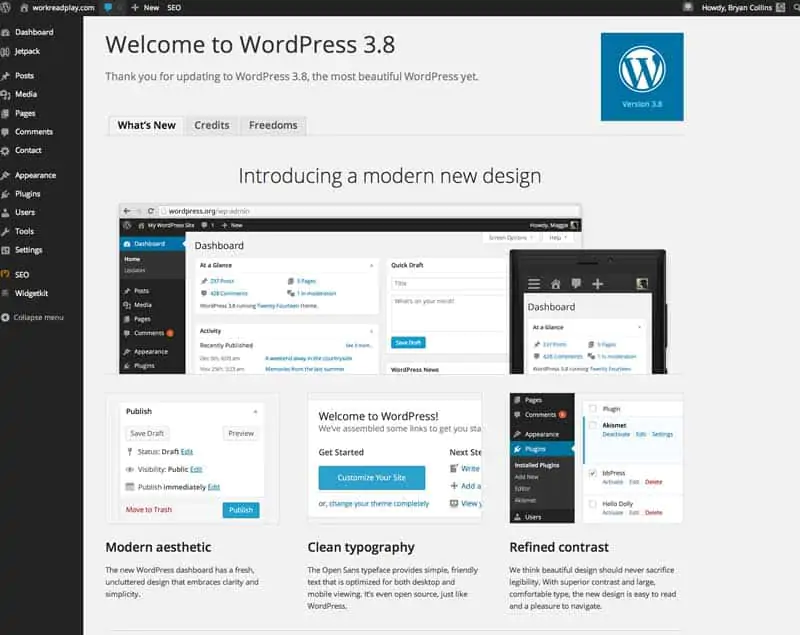An online writing portfolio is key to securing regular writing work from new clients and growing their writing career.
Professional freelance copywriters have a great deal of responsibility for curating their own career opportunities and writing work. Unfortunately, being a blogger often doesn’t generate enough income from ad revenue and direct sales to support writers full time, leaving many looking for paying writing gigs.
Here’s why you should have a freelance writing portfolio, how to make one, and answers to your most frequently asked questions.
Contents
- Why Do I Need a Freelance Writing Portfolio?
- How to Make an Online Writing Portfolio Step By Step
- Step 2. Gather What You Want to Include In Your Online Writing Portfolio
- Step 3. Create a Digital Marketing Strategy
- Step 4. Apply to Freelance Writing Jobs
- Step 5. Hone Your Writing Skills
- Which Is The Best Free Online Multimedia Portfolio?
- The Final Word On Creating An Online Writing Portfolio
- FAQ About How to Make an Online Writing Portfolio
- Should I just create my own website?
- How often should I be blogging on my own website as a content writer?
- Can I just use LinkedIn to publish a few writing samples?
- Should I include recommendations on my portfolio website?
- Does my writer website need a call to action?
- How should I format the content on my online portfolio?
- What if I don’t have any writing samples or clippings?
- What should I post on my social media profiles?
Why Do I Need a Freelance Writing Portfolio?

As more newbie writers become freelancers, it’s becoming more difficult than ever to stand out among the competition. Having a robust portfolio can help you create a formidable online presence, attract new clients, and establish your authority as a copywriting expert. Without good writing portfolio examples, you may find it challenging to secure well-paying work as a content writer.
Benefits of a Portfolio Page As a Freelance Writer
There are numerous benefits of having a portfolio page as a freelance writer or copywriter, including but not limited to:
- A portfolio gives you a place to build your online presence and showcase your personality
- You can feed pages from your portfolio or writer website to your blog and social media pages
- You can use search engine optimization (SEO) to rank above your competition in search results
- You can charge more for your content writing services as a higher-level industry professional
How to Make an Online Writing Portfolio Step By Step
Step 1. Choose Where To Host Your Writer’s Portfolio
Hosting your writer’s portfolio on Blogger or using a Google Doc won’t provide you with the level of professionalism you need to get ahead in the content marketing field.
You can choose an established portfolio website that allows you to plug your information into a premade template, or you can create a custom site of your own. Either way, it’s critical to have a custom domain name that you can put on your business cards, in email signatures, and on your social media profiles. In addition, it should clearly identify your brand and ideally include a highly valuable target keyword in your niche.
Step 2. Gather What You Want to Include In Your Online Writing Portfolio
The next step is putting together the various pieces of work you want to include in your online writing portfolio. Here are some ideas of things to add:
Your Best Writing Samples
At least one section of your website or online portfolio should be dedicated to showcasing your best writing samples. These should be original content or content for which you’ve obtained a release from your client.
If you publish ghostwritten content on your site, you may be sent a notice to remove it for being duplicate content since it was published on your client’s website first. Additionally, once you sell ghostwritten work, you no longer own the copyright and are no longer legally allowed to display it as your writing work unless the new owner of the content gives explicit permission.
Consider publishing samples in multiple different writing niches to showcase your skills. Or, if you prefer to work in a single writing niche, you may want to publish multiple samples on the same topic. The latter allows you to highlight your expertise and authority in a particular niche.
Client Testimonials
A potential employer wants to know what other people you have worked with have to say about your digital marketing and freelancing experience.
Your website or portfolio page should clearly and prominently display your most valuable client testimonials, ideally with engaging graphics to grab user attention. For example, you can include a “five star” graphic for top reviews; this quickly illustrates high marks for users who won’t read through your testimonial text.
Blogging & Guest Post Experience
Most writers who have been freelancing for a period of time have some experience with blogging and/or guest posting.
Guest posting is often considered the crème de la crème of writing samples, especially if the host website is a well-known brand, publisher, or news outlet. Essentially, a guest post on another website means the owner of that site endorses your work, which can be a great accomplishment to showcase in your freelance writing portfolio.
An Outline of Your Writing Career
Potential clients should have a clear idea of how your career has progressed as a content writer or copywriter.
Include a resume or an outline of your writing career that summarizes your work experience in the copywriting or journalism industries. Unless you’ve held prestigious positions or impressive titles before, however, your writing samples should be visible well before your resume. Or, you can simply place your work experience on a separate page on your writer website.
A Contact Form for Prospective Clients
Prospective clients should be able to reach out to you quickly and easily for a quote or to ask questions.
Include a contact form on your contact page and make a habit of checking your email for replies and responding in a timely fashion. The longer you wait to respond to potential clients, the higher the risk is that they will have found another writer to work with in the meantime.
Step 3. Create a Digital Marketing Strategy
Many freelance journalists put effort into creating a digital marketing strategy for their clients without doing the same for their own freelance writing business. However, this newbie mistake can lead to being overlooked by new clients or missing out on higher-paying writing work.
Create a multi-tiered digital marketing strategy that includes regular blogging, posting to social media channels, and publishing authoritative content in your niche under your own byline. You should hit your own marketing as heavily as you would a client for whom you were doing the same thing. If not, you risk losing a lot of potential job opportunities.
Step 4. Apply to Freelance Writing Jobs
Once your writer’s portfolio is ready for prospective clients, it’s time to apply for content marketing and freelance writing jobs. As a freelancer, you should be applying for new writing gigs regularly; it’s always a good idea to have multiple streams of income from several clients than to put all your eggs in one basket, so to speak.
There are several ways to get freelance gigs as a writer, ranging from content mills that take a percentage of the writer’s pay as a “finder’s fee” to job boards where private clients post advertisements for content needed or related positions to fill.
Before selecting jobs, take into consideration your pay versus experience. If you have less experience, you’ll likely need to take on content at a lower pay rate until you build a solid online reputation. On the other hand, if you take longer to write on a particular subject, you may want to charge a higher per-word rate to ensure your hourly earnings stay roughly the same or better.
Step 5. Hone Your Writing Skills
After establishing your writer website, you should work hard to continually improve and evolve your writing skills. Your prospective clients should be confident that you’re able to stay at the forefront of the best writing practices in the industry. Be sure to stay on top of search engine algorithm changes and how they impact the way you write your content.
Potential customers should be able to read your website blogs and get a good idea of your writing style and the quality of your content, even if you haven’t published any other writing samples. They should also be able to see content on relevant topics in your industry that addresses the key issues of your target audience. Blogging is an excellent way for newbie writers to quickly get content on the web with a byline and start building their authority.
Which Is The Best Free Online Multimedia Portfolio?

The best free online multimedia portfolio is the one you like best. While WordPress has a number of free website templates and plugins, it’s perfectly fine if you prefer to look into other portfolio sites. Potential clients won’t know what platform you’re using if you use a custom domain, so feel free to choose which you find the easiest to work with.
Here are some places you can host your writing work to showcase to potential employers.
Contently
Contently is an “end-to-end platform” that offers writers a place to create their online portfolio. It also offers extensive tracking and content management capabilities.
The platform was named a 2021 Leader by G2 in multiple categories, including Overall, Enterprise, and Content Analytics, and was awarded for having the Best Support, Best Relationship, Easiest Setup, and more.
WordPress

WordPress is a longtime leader in the industry and offers copywriters numerous options for creating an online writing portfolio. Estimates place roughly 36% of all websites on a WordPress platform or approximately 455 million sites.
Many content creators are drawn to WordPress because of its versatile design, which doesn’t require copywriters to have PHP expertise in order to set up a successful online portfolio. In addition, because WordPress is self-hosted, there aren’t extra expenses to download or upgrade the system.
Clippings.me
Clippings.me is an online writers profile site that offers two tiers: one completely free tier that is ideal for presenting a limited number of clips and a professional option for $9.99 per month.
It’s currently the highest-ranking portfolio site, which helps boost overall SEO. Popular users of this portfolio provider include the University of Denver, University of Oxford, Freelancers Union, and The Writer Magazine.
Journo Portfolio
Journalists, copywriters, and freelancers can use Journo Portfolio to design a stunning writer’s website. This platform offers the option to automatically import published articles directly into your portfolio. Visitors to your portfolio page can also subscribe to receive notifications when new content is added.
Squarespace
No matter what type of content or multimedia you create, Squarespace allows you to create an online portfolio to house your best work. In addition, writers can include their email address or a pre-built contact form that can be filled out immediately to make it easy for potential employers, clients, and collaborators to contact you.
Pressfolios
Pressfolios is a portfolio host that offers two paid tiers: Lite for $9.99 per month and Pro for $14.99 per month, both with a 14-day free trial. Arguably the most versatile feature of Pressfolios is the ability to back up content with text and screenshots without the need to code.
Muck Rack
Muck Rack is a Public Relations Management (PRM) platform, which is slightly different from the other options on this list. It provides a one-stop-shop for authors to engage in initial research, pitch creation, collaboration, and comprehensive reporting. Popular companies that trust Muck Rack includes but aren’t limited to Taco Bell, Xfinity (formerly Comcast), Pfizer Pharmaceuticals, Casper Mattresses, and A&E television.
Other Portfolio Sites
There are almost limitless options for creating a writer’s website online. Other portfolio sites used by freelance writers, copywriters, and authors in the industry include:
The Final Word On Creating An Online Writing Portfolio
An online writing portfolio is a must-have for professional content marketers and copywriters. Being able to quickly direct potential employers to an online profile that showcases your best work is invaluable.
Ideally, you should constantly update your writer website or other freelance writing portfolio website with your newest writing work and client testimonials.
FAQ About How to Make an Online Writing Portfolio
Should I just create my own website?
Many professional freelance writers choose to create their own websites outside of a rigid platform, allowing them to customize their sites with their preferred colors, fonts, and other branding. If you don’t have experience creating websites, you can use a website builder like Wix or a WordPress template.
Several benefits of having your own portfolio website include:
1. More control and ownership over your best work.
2. Additional opportunities for search engine optimization (SEO) with Google Analytics.
3. Nearly unlimited options for showcasing multimedia.
4. A stronger online presence in your writing niche.
5. Demonstration of your competencies, abilities, and skills.
6. An opportunity to highlight your career growth.
How often should I be blogging on my own website as a content writer?
As a content writer, you should be publishing your own blogs relatively frequently. Once a week is a good minimum to start with; however, remember that consistency is more important than frequency.
Whichever publishing schedule you decide on, make sure it’s one you can consistently keep up with. Users that sign up for your RSS feed so they can be notified of new blogs when they are posted should be able to look forward to your content at approximately the same date and time.
Can I just use LinkedIn to publish a few writing samples?
While LinkedIn is an excellent place to start establishing your online presence as a copywriter, if you’re not a newbie, you’ll likely need more options than this social media platform offers. Social media platforms like Twitter, Facebook, and Instagram are also great places to put writing portfolio examples that can be easily found by potential clients who are also on social media.
Should I include recommendations on my portfolio website?
Yes. If you have recommendation letters from past employers, colleagues, mentors, or teachers, be sure to include PDFs or images of them in your portfolio. If you have references, you can also include these.
Does my writer website need a call to action?
Yes. Ideally, each page on your website will end with a compelling call to action that prompts users to fill out your contact form, call you, or otherwise reach out to you for additional assistance.
How should I format the content on my online portfolio?
Just like your written articles, your writing portfolio should be well formatted and easy to read. Make sure it’s scan and skim friendly and avoid long-winded paragraphs with multiple sentences. Break up your text as much as possible with images, graphics, and other visual elements to keep readers engaged.
What if I don’t have any writing samples or clippings?
Newbie writers that don’t have any published clippings or other writing samples under their byline often have a harder time competing with authors that do. Until you build your portfolio, you can include original writing samples to help potential clients get an idea of your style and flow.
Writers can post a variety of content on their social media channels, from infographics on Instagram to blog posts on Facebook and Twitter. Ideally, your content marketing strategy will include posting regularly to multiple social platforms.
Try not to recycle content between platforms and create content unique to each. This gives users a reason to follow all of your profiles versus just one.